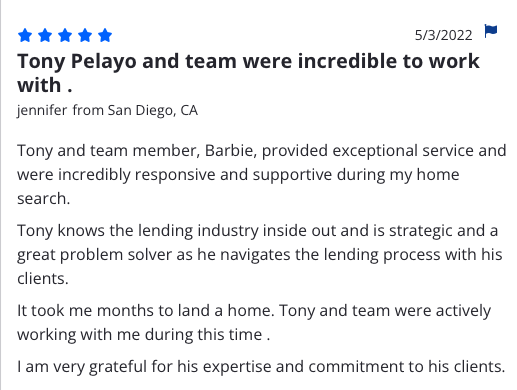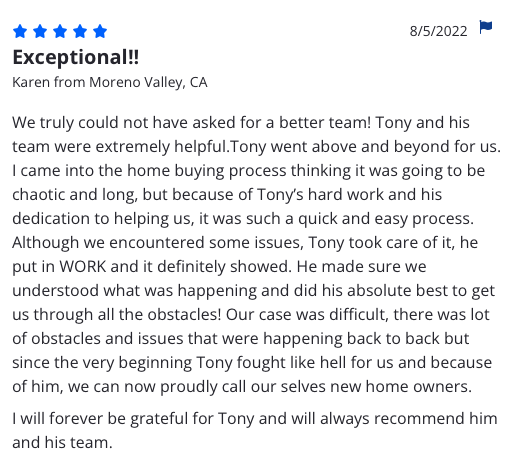2023 VA Loans: Pre-Qualify in Minutes. No Credit Check
Local Lender: Tony Pelayo
Surprisingly Great Rates! (Better than your credit union or large bank!)
Challenging situations, no problem – We’ll close!
Learn More About Your Lender!
Tony Pelayo
As of January 1st, 2020, the VA has changed its loan limit to NO LIMIT! With full entitlement intact, lenders will have different requirements on their loan limits based on your FICO score. At APM, our minimum credit score is just 640 if your loan amount is below the county loan limit. Anything over that is on a case-by-case basis.
No Limit Other Than That of Your Eligibility
Keep Reading To See How You Can QUALIFY!
Veterans, Active-Duty Service Members, and Surviving Spouses may qualify for a VA loan if they have satisfactory credit, adequate income, and a valid Certificate of Eligibility.
Learn How a VA Loan works and can benefit you!
We’d just like to say; Thank you for your service!
We’ve helped THOUSANDS of people get into homes through VA Loans!






What does the process look like:
Step 1 – Select a VA-approved Lender:
On the surface, it might appear that any lender will do. However, if you dig a little deeper, you may discover that not all lenders are the same. First, only lenders approved by the U.S. Department of Veterans Affairs can originate VA mortgages. Secondly, some lenders focus primarily on conventional loans, while others concentrate almost exclusively on the VA loan program for military clients. Using a VA specialty lender with extensive knowledge about the VA loan process vs. a lender who only funds a few VA mortgages a year may translate into an easier and quicker loan process.
Step 2 – Obtain a Certificate of Eligibility:
An experienced lender can help you obtain what’s called a Certificate of Eligibility (COE). The COE will prove that you meet initial eligibility standards for VA loan benefits. It will also let the lender know how much entitlement you can receive, which is the amount the Department of Veterans Affairs will guarantee on your VA loan. To get your COE, you’ll need to give your lender a bit of information about your military service. Usually, a COE can be acquired online instantly through a lender’s portal or through the eBenefits portal on the va.gov website. Those servicemembers or surviving spouses whose COEs cannot be obtained online will have to get theirs by mail. A VA lender or the VA can help direct you to the right resource for your specific situation.
Step 3 – Pre-Qualify for Your Loan Amount (optional):
Pre-qualifying is important, but not required. By choosing to complete this step you can save some time and potential surprises later in the process. To pre-qualify for your loan amount, you’ll have a candid conversation with your VA loan professional about your income, credit history, employment, marital status and other factors. Giving your lender complete details during the pre-qualifying step can help prevent surprises later during underwriting. The pre-qualifying step can also reveal areas that need improvement before you can be approved, such as credit or debt-to-income ratio. While a prequalification letter gives you a ballpark price range for house hunting, it does not guarantee that you will be approved for a loan, and your lender will later have to verify the information you provide. To get a loan requires later final approval by underwriting once all documents have been received and reviewed (see Step 5).
Step 4 – Go House Hunting and Sign a Purchase Agreement:
The fourth step is usually one buyers enjoy because they get to look at homes they might consider buying. Working with a real estate professional who specializes in the VA process can help you get the most out of your benefits. This is true because the VA allows certain fees and costs to be paid by the seller (if both you and the seller agree), and a knowledgeable agent will know this and help you negotiate seller-paid fees. Once you’ve got a signed purchase agreement, you can move forward in the VA loan process.
Step 5 – Lender Processes Application and Orders VA Appraisal:
A signed purchase contract is the document you’ll need to finish your initial application. Once your lender has the contract, they will order the VA appraisal. Here again, not just any appraiser will do. Only a professional who is certified to perform appraisals to VA standards can evaluate the home being considered for VA financing. The VA appraiser will make sure the price you’ve agreed to pay for the home corresponds with the current value. Another very important part of the VA appraisal is to inspect the home to make sure it meets the VA minimum property requirements (VA MPRs). However, the VA appraisal does not take the place of a home inspection, which focuses on code violations, defects and the condition of the property. While many borrowers have heard horror stories about the length of the VA appraisal process, the Department of Veterans Affairs gives the appraisers 10 days from order to completion barring extenuating circumstances. While you’re waiting for appraisal documents, you’ll be busy submitting documents of your own to your VA-approved lender to show you have the ability to qualify for the loan. If the home passes appraisal for value and VA minimum property requirements, and it’s verified by the lender that you qualify for your loan, the underwriter will give his or her stamp of approval.
Step 6 – Close on Your Loan and Move In:
After being approved by the underwriter, all that is left to do is close and move in. During closing, the property legally transfers from the former owner to you. Closing is a step that requires you to sign documents that confirm you understand and agree to the terms of the loan. You will need to provide proof of homeowners insurance and, if required, pay closing costs. Once you’ve signed all your closing documents, you’ll get the keys to your new home.
While these steps may not happen in the exact order above or be required as part of a pre-qualification, the represent the typical process for the applicant to obtain the VA Loan. Your lender may need to take other steps.
V.A. Loan Advantages
No Down Payment
By far, the single-largest benefit of the VA loan is that qualified Veterans can purchase without a down payment. This huge advantage allows Veterans and service members to buy homes without having to spend years saving for that typical lump-sum payment.
Competitively Low Interest Rates
Here’s another big way the VA loan program saves Veterans money: Having the lowest average fixed rates on the market.
VA loans have had the lowest average 30-year fixed rate on the market for the last six years, according to data from ICE Mortgage Technology.
VA interest rates are typically 0.5 to 1 percent lower than conventional interest rates. Lower rates help Veterans save every month and over the life of their loan.
Limited Closing Costs
All mortgages come with fees and closing costs, but the VA actually limits what Veterans can be charged when it comes to these expenses. In fact, some costs and fees must be covered by other parties in the transaction. These safeguards help make homeownership affordable for qualified homebuyers.
Frequently Asked Questions:
What is not allowed for a VA loan?
Real estate attorney fees: Attorney fees are not allowed for VA home loans. Real estate broker fees: You cannot pay for real estate broker fees when buying a home with a VA loan. Agent or Realtor fees: VA borrowers cannot pay real estate agent fees.
What will cause VA loan to get disapproved?
The most common reason why VA home loan applications get denied is because of errors on the application itself. Lenders can’t issue loans unless they’re sure that your personal and financial details are correct. Before you submit your application, take the time to review each statement you make and numbers you enter.
Is there a 90 day rule for VA loans?
You may have heard of a VA 90-day flip rule that says you must flip the home within 90 days of you being on the title. This is not true. Many people confuse the FHA 90-day flip rule with the VA.
The VA does not have any flip rules in its official lending guidelines.
What is the VA 1% rule?
38 C.F.R. 36.4813 limits the fees that a veteran may pay when obtaining a VA-guaranteed home loan.
Veterans may pay a maximum of a one percent origination fee charged by the lender (plus reasonable discount points) as well as reasonable and customary amounts for certain itemized fees.
What is the credit limit for a VA loan?
Eligible Veterans, service members, and survivors with full entitlement
no longer have limits on loans over $144,000. This means you won’t have to pay a down payment, and we guarantee to your lender that if you default on a loan that’s over $144,000, we’ll pay them up to 25% of the loan amount.
Can a VA loan be denied at closing?
Although it’s rare for lenders to deny VA Loan applications, it does happen on occasion.
How often does a VA loan get denied?
VA loan denial isn’t uncommon. According to HMDA data, 12% of VA loan applications received a denial in Q2 of 2022, compared to 17% of FHA loans.
How long does a VA loan take to approve?
How Long Does it Take to Close a VA Loan? Most VA loans close in 40 to 50 days, which is standard for the mortgage industry regardless of the type of financing. In fact, dig into the numbers a bit and you don’t find much difference between VA and conventional loans.

You can find more info at:
https://tonypelayo.com/links
https://www.instagram.com/tony_tman_pelayo/
https://www.facebook.com/MortgageLoanOfficer
Mortgage Loan Officer/ Branch Manager
NMLS: 1501920 I NMLS: 1421 | APM: 1850
Equal Housing Opportunity
AZ BK 0906702
Licensed by the Dept of Financial Protection and Innovation under the CRMLA
Georgia Residential Mortgage Licensee
Licensed in AZ, CA, GA, TN, TX, WA
https://www.apmortgage.com/tony-pelayo
www.nmlsconsumeraccess.org
All information contained herein is for informational purposes only and, while every effort has been made to ensure accuracy, no guarantee is expressed or implied. Any programs shown do not demonstrate all options or pricing structures. Rates, terms, programs and underwriting policies subject to change without notice. This is not an offer to extend credit or a commitment to lend. All loans subject to underwriting approval. Some products may not be available in all states and restrictions apply. PURSUANT TO THE REQUIREMENTS OF SECTION 157.007 OF THE MORTGAGE BANKER REGISTRATION AND RESIDENTIAL MORTGAGE LOAN ORIGINATOR ACT, CHAPTER 157, TEXAS FINANCE CODE, YOU ARE HEREBY NOTIFIED OF THE FOLLOWING: CONSUMERS WISHING TO FILE A COMPLAINT AGAINST A MORTGAGE BANKER OR A LICENSED MORTGAGE BANKER RESIDENTIAL MORTGAGE LOAN ORIGINATOR SHOULD COMPLETE, SIGN AND SEND A COMPLAINT FORM TO THE TEXAS DEPARTMENT OF SAVINGS AND MORTGAGE LENDING, 2601 NORTH LAMAR, SUITE 201, AUSTIN, TEXAS 78705. COMPLAINT FORMS AND INSTRUCTIONS MAY BE DOWNLOADED AND PRINTED FROM THE DEPARTMENT’S WEBSITE AT WWW.SML.TEXAS.GOV. A TOLL-FREE CONSUMER HOTLINE IS AVAILABLE AT 1-877-276-5550. THE DEPARTMENT MAINTAINS A RECOVERY FUND TO MAKE PAYMENTS OF CERTAIN ACTUAL OUT OF POCKET DAMAGES SUSTAINED BY BORROWERS CAUSED BY ACTS OF LICENSED MORTGAGE BANKER RESIDENTIAL MORTGAGE LOAN ORIGINATORS. A WRITTEN APPLICATION FOR REIMBURSEMENT FROM THE RECOVERY FUND MUST BE FILED WITH AND INVESTIGATED BY THE DEPARTMENT PRIOR TO THE PAYMENT OF A CLAIM. FOR MORE INFORMATION ABOUT THE RECOVERY FUND, PLEASE CONSULT THE DEPARTMENTS WEB SITE AT WWW.SML.TEXAS.GOV.
Ⓒ 2024, Tony Pelayo. All Rights Reserved.
Web Design by mskctg
Website managed by threestrandmedia.com